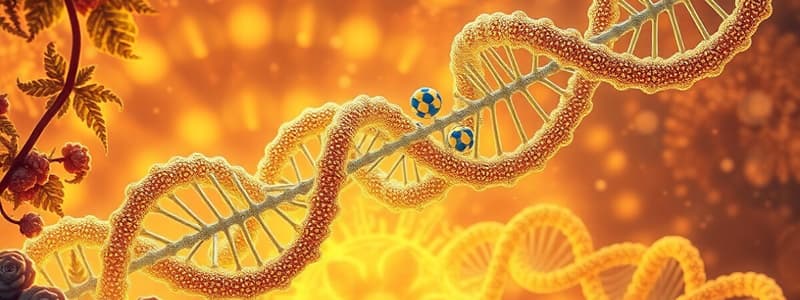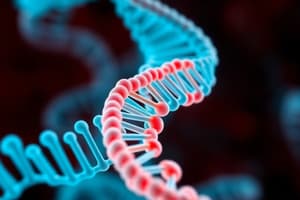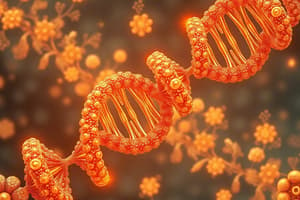Podcast
Questions and Answers
Which statement accurately describes the role of RNA polymerase in transcription?
Which statement accurately describes the role of RNA polymerase in transcription?
- It catalyzes the formation of phosphodiester bonds between ribonucleotides. (correct)
- It synthesizes proteins from an mRNA template.
- It degrades mRNA molecules after translation.
- It synthesizes DNA from an RNA template.
How does the antisense strand contribute to the production of mRNA?
How does the antisense strand contribute to the production of mRNA?
- It directly codes for the amino acid sequence in translation.
- It inhibits the function of the sense strand to prevent errors in transcription.
- It is identical to the mRNA sequence, ensuring direct transfer of genetic information.
- It serves as a template for creating a complementary mRNA sequence. (correct)
In prokaryotes, what is the primary function of the sigma (σ) factor?
In prokaryotes, what is the primary function of the sigma (σ) factor?
- To stabilize the assembled holoenzyme structure.
- To direct RNA polymerase to specific promoter sequences on the DNA. (correct)
- To catalyze the elongation of the mRNA molecule.
- To terminate transcription upon reaching a termination sequence.
What would be the mRNA sequence transcribed from the DNA template strand with the sequence 3'-TAC-5'?
What would be the mRNA sequence transcribed from the DNA template strand with the sequence 3'-TAC-5'?
What is the key difference between eukaryotic and prokaryotic RNA polymerases?
What is the key difference between eukaryotic and prokaryotic RNA polymerases?
What happens to the sigma factor after RNA polymerase initiates transcription and moves beyond the promoter region?
What happens to the sigma factor after RNA polymerase initiates transcription and moves beyond the promoter region?
How does negative supercoiling of DNA facilitate transcription?
How does negative supercoiling of DNA facilitate transcription?
Why is the formation of an RNA hairpin followed by a series of uracil nucleotides important for transcriptional termination in some organisms?
Why is the formation of an RNA hairpin followed by a series of uracil nucleotides important for transcriptional termination in some organisms?
What is the function of gene regulatory proteins in controlling transcription?
What is the function of gene regulatory proteins in controlling transcription?
How does the zinc finger motif assist in DNA binding?
How does the zinc finger motif assist in DNA binding?
What is the role of allolactose in regulating the lac operon?
What is the role of allolactose in regulating the lac operon?
If a mutation occurred in the lacI gene that prevented the repressor protein from binding to allolactose, what would be the likely effect on transcription of the lac operon?
If a mutation occurred in the lacI gene that prevented the repressor protein from binding to allolactose, what would be the likely effect on transcription of the lac operon?
How does the polycistronic mRNA produced by the lac operon in bacteria differ from mRNA in eukaryotes?
How does the polycistronic mRNA produced by the lac operon in bacteria differ from mRNA in eukaryotes?
What is the consequence of mutations in the promoter region of a gene?
What is the consequence of mutations in the promoter region of a gene?
What is the function of the two zinc ions that bind to the β' subunit of E. coli polymerase?
What is the function of the two zinc ions that bind to the β' subunit of E. coli polymerase?
What feature of the holoenzyme ensures that transcription begins at the correct location?
What feature of the holoenzyme ensures that transcription begins at the correct location?
How is the holoenzyme complex formed during E. coli transcription?
How is the holoenzyme complex formed during E. coli transcription?
What structural aspect of the E. coli core polymerase enables it to perform transcription?
What structural aspect of the E. coli core polymerase enables it to perform transcription?
Initiation of transcription involves different steps. What is the correct order?
Initiation of transcription involves different steps. What is the correct order?
What factors assist the termination of transcription?
What factors assist the termination of transcription?
Flashcards
What is transcription?
What is transcription?
Process of creating mRNA from DNA, catalyzed by RNA polymerase, carrying genetic info to ribosomes.
What is translation?
What is translation?
Enzymatic synthesis of protein from mRNA.
What is RNA Polymerase?
What is RNA Polymerase?
Enzyme catalyzing mRNA synthesis using a DNA template.
What is a promoter?
What is a promoter?
Signup and view all the flashcards
What is the antisense strand?
What is the antisense strand?
Signup and view all the flashcards
What is the sense strand?
What is the sense strand?
Signup and view all the flashcards
Promoter sequence
Promoter sequence
Signup and view all the flashcards
Transcription elongation
Transcription elongation
Signup and view all the flashcards
What is an RNA hairpin?
What is an RNA hairpin?
Signup and view all the flashcards
Termination sequence
Termination sequence
Signup and view all the flashcards
Transcription controls
Transcription controls
Signup and view all the flashcards
Gene regulatory proteins
Gene regulatory proteins
Signup and view all the flashcards
Zinc finger motif
Zinc finger motif
Signup and view all the flashcards
What is the lac operon?
What is the lac operon?
Signup and view all the flashcards
Plac (promoter)
Plac (promoter)
Signup and view all the flashcards
Olac (operator)
Olac (operator)
Signup and view all the flashcards
laci (gene)
laci (gene)
Signup and view all the flashcards
Lactose induction
Lactose induction
Signup and view all the flashcards
Study Notes
- Transcription involves the creation of messenger RNA (mRNA) from a DNA template and is catalyzed by RNA polymerase.
- mRNA temporarily copies DNA and carries genetic information to ribosomes for protein synthesis.
- Translation is the enzymatic synthesis of protein from the mRNA sequence transcribed from a gene.
RNA Polymerase
- Prokaryotes possess a single RNA polymerase responsible for transcribing mRNA, ribosomal RNA (rRNA), and transfer RNA (tRNA).
- Eukaryotes have three distinct RNA polymerases:
- Polymerase 1 transcribes most rRNA.
- Polymerase 2 transcribes all protein-coding genes into mRNA.
- Polymerase 3 transcribes tRNA, which brings amino acids to ribosomes.
Transcription Initiation
- Initiation involves RNA polymerase binding to double-stranded DNA at a promoter sequence.
- The promoter sequence is a regulatory DNA sequence upstream of the gene to be transcribed.
- Promoter activity is influenced by sequence elements and bound proteins that activate or suppress gene expression.
- Double-stranded DNA must be unwound locally for RNA polymerase to access the promoter sequence.
- mRNA synthesis starts at a specific nucleotide 'start site' or 'initiation site,' designated position +1.
DNA Strands in Transcription
- The sense strand carries the gene sequence copied into mRNA and translated into protein.
- The antisense strand serves as a template for generating a copy of the sense strand through complementary base pairing.
- The antisense strand ensures the RNA polymerase produces an exact copy of the sense strand sequence and produces a copy of the sense strand
- The sense strand sequence is 5'-A TG-3', the antisense strand is 3'-T A C-5', and the resulting mRNA is 5'-A U G-3'.
- The antisense strand also carries gene sequences for non-coding RNA molecules, such as transfer RNA.
Transcription Elongation
- RNA polymerase adds nucleotides to the 3' end of the growing mRNA molecule in the 5' to 3' direction.
- The polymerase moves along the antisense strand in the 3' to 5' direction, unwinding the DNA helix and creating a complementary mRNA sequence.
- The DNA helix reforms after unwinding and use.
- In E. coli, the enzyme synthesizes approximately 40 base pairs per second at 37 degrees.
E. Coli Polymerase Subunits
- E. coli polymerase consists of five subunits that work together to transcribe DNA.
- The complete holoenzyme includes all subunits, but the core enzyme, which lacks the sigma subunit, travels along the DNA.
- The complete holoenzyme helps polymerase recognize and bind to the promoter sequence.
- The core enzyme copies DNA into mRNA.
- There are two alpha subunits required for holoenzyme assembly.
- One B-subunit forms the catalytic center of the enzyme.
- One Beta'-subunit binds two Zinc ions to help catalyse the joining of ribonucleotides.
- One w-subunit stabilizes the assembled holoenzyme.
- One σ-subunit facilitates promoter recognition.
E. Coli Promoter Regions
- The region from -20 to +20 is strongly associated with the holoenzyme.
- The region from -40 is required for efficient transcription; elements before this region are less crucial.
E. Coli Transcription Process
- The core polymerase binds non-specifically to any random sequence on DNA with weak affinity.
- The sigma factor joins the core polymerase to form a holoenzyme, directing it to a specific promoter sequence and increasing binding affinity up to 100-fold.
- Key regions recognized are the -35 box and -10 box.
- Upon finding these regions, the holoenzyme binds tightly to the promoter without unwinding DNA, ensuring correct positioning.
- The polymerase unwinds the antisense strand to form an open complex.
Transcription Initiation (cont.)
- RNA synthesis in E. coli can initiate without a primer.
- Almost all RNA has a purine (A or G) at its 5' end, with guanine being more common.
- The first two ribonucleotides are linked by a phosphodiester bond and starts with either GTP or ATP.
- The first nine bases can be linked without the enzyme moving, allowing for abortion if errors occur.
- polymerase can queue for initiation when there's a fast growth rate in E. coli, with the decision on whether to transcribe made quickly (1-2 seconds).
Transcription Elongation
- Once the decision to transcribe is made, the sigma factor creates a ternary complex with polymerase, DNA, and nascent RNA.
- The constant unwound area spans 17 base pairs at the rate of 40 base pairs per second.
- The 12 bp RNA-DNA hybrid acts as a dynamic anchor, stabilizing RNA polymerase, ensuring processivity, and preventing premature termination while enabling smooth peeling of the growing RNA strand.
E. Coli Transcription Termination
- Upon reaching a termination sequence, RNA polymerase detaches from DNA.
- mRNA folds back due to complementary base pairing of an mRNA sequence section which creates a stable loop that causes the RNA polymerase to pause.
- The presence of four or more uracil (U) nucleotides following the hairpin weakens the association between mRNA and the DNA template and leads to polymerase detaching, ending transcription.
Factors Influencing Gene Transcription
- Transcription controls are paramount in determining organism function.
- Gene regulation is achieved through regulatory regions of DNA located near the transcription site.
- The regulatory region act as a switch that controls it regulation by either allowing or blocking transcription.
- Prokaryotic regulation involves simple switch mechanisms
- Eukaryotic regulation employs more complex, microprocessor-style regulation.
Gene Regulatory Proteins
- Regulatory proteins act as switches and bind to specific regulatory regions of DNA, controlling gene expression.
- Proteins interact with DNA using hydrogen bonds and hydrophobic interactions on the major groove
- Proteins contain zinc finger motifs to help bind to DNA.
- Proteins containing helix-turn-helix motifs bind to the major groove of DNA, influencing gene expression during development.
- Zinc ions bound to the proteins are responsible for maintaining correct protein folding.
E. Coli Lactose Metabolism
- E. coli bacteria can use lactose as a carbon source for energy.
- The lac operon is a group of genes that works together to control lactose metabolism, acting as a central control unit.
3 Key Enzymes
- Galactose permease (lacY) transports lactose into the cell.
- Beta-galactosidase (lacZ) breaks down lactose into glucose and galactose.
- Thiogalactoside transacetylase (lacA) has an unknown physiological function.
- The lac operon produces a single polycistronic mRNA encoding the three enzymes needed for lactose metabolism.
Lac Operon Components
- Plac - the promoter region where RNA polymerase binds.
- Olac - the operator region where the repressor protein binds.
- laci - the gene encoding the repressor protein.
- The repressor binds to the operator and blocks RNA polymerase at the promoter, preventing transcription.
Lac Operon Response with Lactose
- Lactose induction occurs when lactose is converted into allolactose.
- Allolactose binds to the lac repressor protein, causing it to change shape and detach from the operator.
- The RNA polymerase can bind to the promoter and initiate transcription of the genes with enzymes needed for lactose metabolization.
- The cell efficiently produces mRNA needed to break down lactose for energy.
Studying That Suits You
Use AI to generate personalized quizzes and flashcards to suit your learning preferences.



